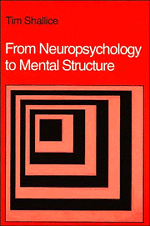Book contents
- Frontmatter
- Contents
- Preface
- I Introducing Cognitive Neuropsychology
- II Converging Operations: Specific Syndromes and Evidence from Normal Subjects
- III Inferences from Neuropsychological Findings
- IV Central Processes: Equipotentiality or Modularity?
- 12 Selective Impairments of Knowledge
- 13 The Allocation and Direction of Processing Resources: Visual Attention
- 14 The Allocation of Processing Resources: Higher-Level Control
- 15 Amnesia: What Is Memory For?
- 16 Modularity and Consciousness
- References
- Subject Index
- Author Index
- Index of Patients Cited
13 - The Allocation and Direction of Processing Resources: Visual Attention
from IV - Central Processes: Equipotentiality or Modularity?
Published online by Cambridge University Press: 21 October 2009
- Frontmatter
- Contents
- Preface
- I Introducing Cognitive Neuropsychology
- II Converging Operations: Specific Syndromes and Evidence from Normal Subjects
- III Inferences from Neuropsychological Findings
- IV Central Processes: Equipotentiality or Modularity?
- 12 Selective Impairments of Knowledge
- 13 The Allocation and Direction of Processing Resources: Visual Attention
- 14 The Allocation of Processing Resources: Higher-Level Control
- 15 Amnesia: What Is Memory For?
- 16 Modularity and Consciousness
- References
- Subject Index
- Author Index
- Index of Patients Cited
Summary
The Problems of Parallel Processing
The modular model of the mind that is suggested by cognitive neuropsychology research contains a conceptual lacuna. The existence of many special-purpose processing systems, each of which can operate autonomously, would not seem sufficient to produce coherent and effective operation for the whole system. Does this function itself require special-purpose units?
Another aspect of the functional architecture, in addition to modularity, needs to be considered in responding to this question. It has been widely assumed in theorising on cognitive processes that all the routine cognitive and motor skills that we have are controlled by more or less program-like entities, such as ‘productions’ (e.g. Newell & Simon, 1972) or action or thought ‘schemata’ (Schmidt, 1975; Rumelhart & Ortony, 1977). It is presumed that just as the mind contains representations of a finite but large and extensible set of words, so it contains a large but finite set of action or thought schemata. What would any individual thought or action schema control? There would be an enormous variety of operations. Take, for instance, how to use a table knife for cutting, for pushing, or for spreading food; how to subtract one number from another; how to rotate an object mentally; and so on. Moreover, schema control would be on multiple levels; so the schema for making a sandwich could call those for cutting bread and for spreading butter.
- Type
- Chapter
- Information
- From Neuropsychology to Mental Structure , pp. 307 - 327Publisher: Cambridge University PressPrint publication year: 1988



